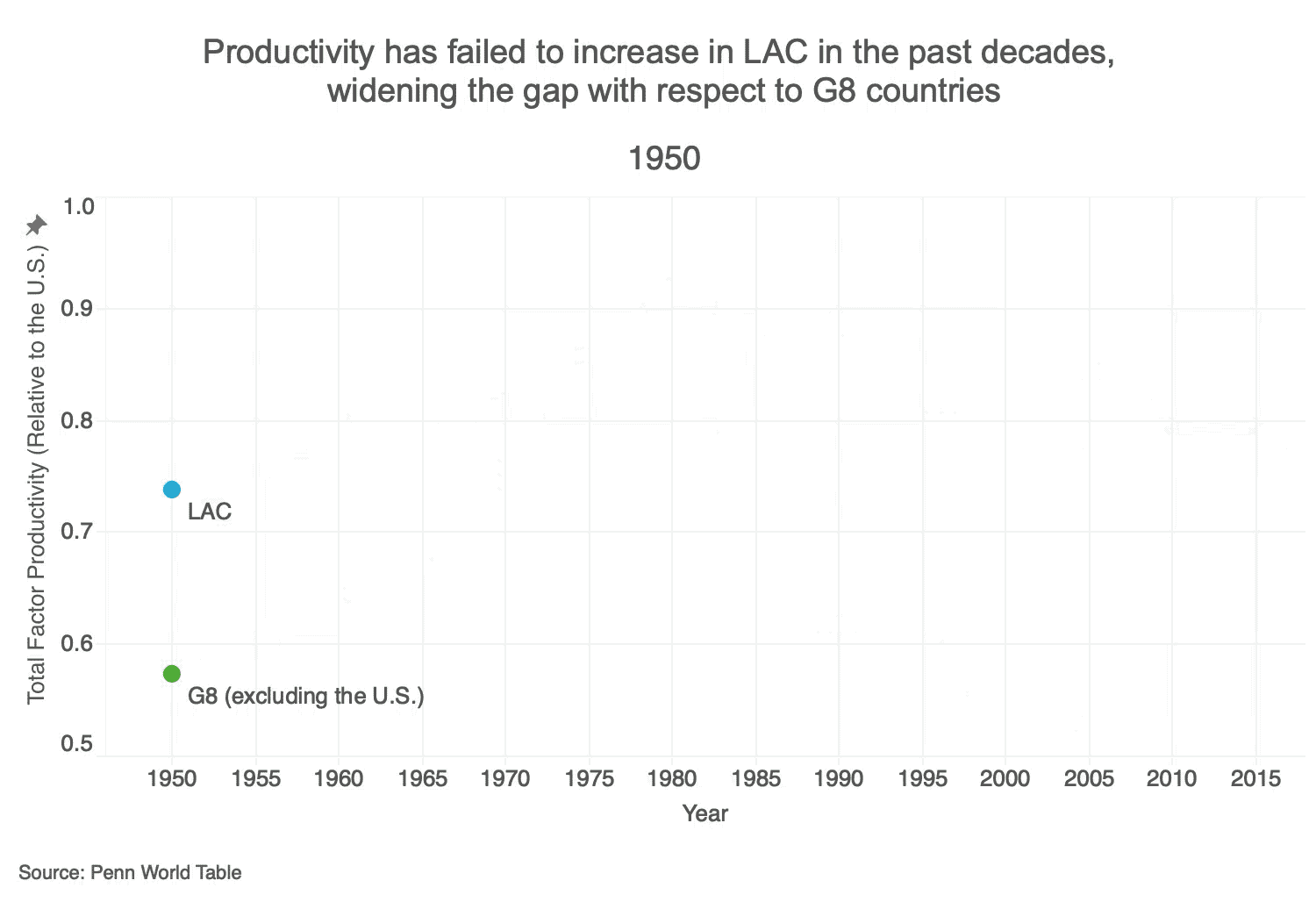Where did the productive capacity go?
February 7, 2019
In recent decades, Latin American and Caribbean (LAC) countries have invested heavily in both human and physical capital. One example: secondary and tertiary education completion rates have increased, changing radically the schooling composition of the labour force.
Yet, growth in the region has been disappointing. As an underlying determinant of such poor performance, productivity has failed to increase, widening the gap with respect to high-income economies. Consider the figure above featuring the evolution of total factor productivity (TFP) in LAC, which broadly speaking measures the efficiency with which factors of production are combined to produce goods and services.
Since the 1980s, in most LAC countries TFP has been a decreasing fraction of that of the US. This is explained mainly because the US TFP level has increased and LAC’s has remained stagnant. Weak TFP growth is a symptom of countries not taking full advantage of their capacities. In other words, LAC countries don’t grow despite their investments because they are not able to capitalize their returns. The question is, why?
There is no definite answer, but a compelling argument is that human and physical capital are “misallocated.” That is, they are not allocated to their most productive use. There are a number of ways in which misallocation happens. One is when individuals are employed in occupations that do not use their talents and abilities. Imagine if Cristiano Ronaldo is sent to play tennis and Serena Williams to play soccer. Another example is when productive companies face restrictions to grow and either remain small or are forced out of the market. Finally, workers and firms can also be sub-optimally matched.
There are many stories in Latin American and Caribbean cities about college graduates, say engineers, driving taxis. Let us give an example presented recently by a well-known researcher. Think about a number of taxi drivers, working independently; each taxi a one-worker enterprise which requires only driving skills. Now think of the same number taxis coming together in a transportation company. Now, the company would need an engineer for logistics, a lawyer, an accountant, in addition to drivers. Not only that, but the company could improve the individual productivity of each taxi driver, potentially introducing new technologies that allow for a better utilization of assets, and thus, the productivity not only of the transport sector, but other sectors for which transport is an input. If there are constraints for firm growth –related to financial sector, fiscal systems, contract enforcement, or others- the companies will remain small and the people with skills will be penalized in their earnings.
As explained by Santiago Levy in his recent book Unrewarded Efforts, misallocation is a consequence of policies and institutions that impact the behavior of workers and entrepreneurs to the detriment of productivity. Misallocation can results from policies, such as fiscal policy, trade policy, labour regulations, and social insurance policies. It can also result due to the institutional environment: the extent to which institutions are able to enforce rules and regulations and provide basic services.
In formal terms, an efficient allocation would be one in which the value that can be obtained with one unit of capital and labor is the same regardless of the firm to which that unit is allocated (Hsieh and Klenow. 2009). Thus, according to one line of thinking, a way of measuring the inefficiency in an environment is to observe the dispersion of TFP of firms within a specific sector: the greater this dispersion, the greater the degree of misallocation. Table 1 shows the dispersion of the physical TFP of firms, taking into account the fact that firms produce different goods in different LAC countries.
What we observe is that, within narrowly defined industries, some firms are able to produce significantly more output than others, using the same amount of inputs. Consider the case of Ecuador: in 2005 a firm in the top 90th percentile of productivity was 286 percent more productive than a comparable firm in the 10th percentile.
On the labor market side we find a similar kind of distortion, in particular, of how investment in education is remunerated. In an perfectly functioning market, we would expect that more educated individuals would be more productive, and thus, earn more than less educated, less productive, individuals. We call this “extra” wage for additional years of education a wage premium. Table 2 shows the change in the wage premium of skilled versus unskilled workers for the last few decades in LAC countries. Skilled workers are those with some tertiary education, while unskilled workers have a high school diploma or lower educational attainment. We observe that for most countries there is steady drop in the education premium. This has been argued in Rodríguez-Castelán et al (2016).
One explanation for this distortion is that educated workers are not able to find jobs where they can deploy the skills acquired. In an environment where firms have incentives to remain small and informal, they are less likely to invest, grow, become more productive, and thus, hire more educated workers.
Other causes typically cited to be behind the misallocation of resources and the dispersion of TFP among firms are (i) cost of entry (and exit), (ii) learning (initial conditions and after changing products/processes), (iii) adjustment costs for factors of production and (iv) access to credit constraints.
To improve productivity and reignite growth, LAC countries will need to address the bottlenecks to the optimal allocation of resources. This post has just pointed to the usual suspects, but bottlenecks and how to address them are always country-specific; there is no unique prescription to address the productivity puzzle. In each country context, development efforts will need to focus on removing the existing “artificial” barriers to productivity growth and working to smooth the “natural” ones. There’s no need to reinvent the wheel but only to fix it.

 Locations
Locations


